Africa, the second largest continent (after Asia), covering about one-fifth of the total land surface of Earth. The continent is bounded on the west by the Atlantic Ocean, on the north by the Mediterranean Sea, on the east by the Red Sea and the Indian Ocean, and on the south by the mingling waters of the Atlantic and Indian oceans.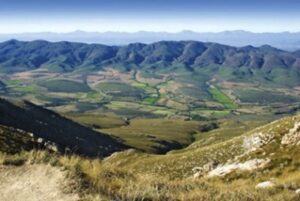 Africa’s total land area is approximately 11,724,000 square miles (30,365,000 square km), and the continent measures about 5,000 miles (8,000 km) from north to south and about 4,600 miles (7,400 km) from east to west. Its northern extremity is Al-Ghīrān Point, near Al-Abyaḍ Point (Cape Blanc), Tunisia; its southern extremity is Cape Agulhas, South Africa; its farthest point east is Xaafuun (Hafun) Point, near Cape Gwardafuy (Guardafui), Somalia; and its western extremity is Almadi Point (Pointe des Almadies), on Cape Verde (Cap Vert), Senegal. In the northeast, Africa was joined to Asia by the Sinai Peninsula until the construction of the Suez Canal. Paradoxically, the coastline of Africa—18,950 miles (30,500 km) in length—is shorter than that of Europe, because there are few inlets and few large bays or gulfs.Off the coasts of Africa a number of islands are associated with the continent. Of these Madagascar, one of the largest islands in the world, is the most significant. Other, smaller islands include the Seychelles, Socotra, and other islands to the east; the Comoros, Mauritius, Réunion, and other islands to the southeast; Ascension, St. Helena, and Tristan da Cunha to the southwest; Cape Verde, the Bijagós Islands, Bioko, and São Tomé and Príncipe to the west; and the Azores and the Madeira and Canary islands to the northwest.
Africa’s total land area is approximately 11,724,000 square miles (30,365,000 square km), and the continent measures about 5,000 miles (8,000 km) from north to south and about 4,600 miles (7,400 km) from east to west. Its northern extremity is Al-Ghīrān Point, near Al-Abyaḍ Point (Cape Blanc), Tunisia; its southern extremity is Cape Agulhas, South Africa; its farthest point east is Xaafuun (Hafun) Point, near Cape Gwardafuy (Guardafui), Somalia; and its western extremity is Almadi Point (Pointe des Almadies), on Cape Verde (Cap Vert), Senegal. In the northeast, Africa was joined to Asia by the Sinai Peninsula until the construction of the Suez Canal. Paradoxically, the coastline of Africa—18,950 miles (30,500 km) in length—is shorter than that of Europe, because there are few inlets and few large bays or gulfs.Off the coasts of Africa a number of islands are associated with the continent. Of these Madagascar, one of the largest islands in the world, is the most significant. Other, smaller islands include the Seychelles, Socotra, and other islands to the east; the Comoros, Mauritius, Réunion, and other islands to the southeast; Ascension, St. Helena, and Tristan da Cunha to the southwest; Cape Verde, the Bijagós Islands, Bioko, and São Tomé and Príncipe to the west; and the Azores and the Madeira and Canary islands to the northwest.
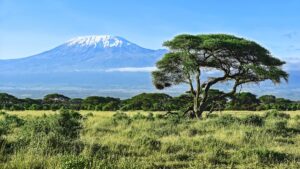
Mount Kilimanjaro
Mount Kilimanjaro
Mount Kilimanjaro is a majestic and iconic mountain located in Tanzania, East Africa. It is the tallest freestanding mountain in the world, rising approximately 5,895 meters (19,341 feet) above sea level. Kilimanjaro is also Africa’s highest peak and one of the continent’s most popular destinations for mountaineering and trekking.
Here are some key facts and information about Mount Kilimanjaro:<br> Location: Mount Kilimanjaro is situated in northeastern Tanzania, near the border with Kenya. It is part of the Kilimanjaro National Park and is about 300 kilometers (186 miles) south of the equator.
Volcanic Origins: Kilimanjaro is a dormant stratovolcano composed of three volcanic cones: Kibo, Mawenzi, and Shira. Kibo, the highest and central cone, is where the summit Uhuru Peak is located.
Climbing Routes: There are several routes to reach the summit of Kilimanjaro, each varying in difficulty and scenery. The most popular routes include the Marangu Route (also known as the “Coca-Cola Route”), Machame Route, Lemosho Route, and Rongai Route.
Ecological Diversity: Kilimanjaro encompasses a diverse range of ecosystems and vegetation zones due to its significant elevation gradient. The lower slopes are home to cultivated farmlands and rainforests, followed by heath and moorland, alpine desert, and finally, the snow-capped summit.
Wildlife: Despite the harsh conditions, Kilimanjaro supports unique wildlife. The lower slopes host species such as elephants, buffalo, leopards, and primates. However, the higher altitudes are relatively barren, with fewer animal species.
Climate: Kilimanjaro’s climate varies with altitude. The lower slopes experience a tropical climate, while the higher regions are characterized by cold temperatures and unpredictable weather. It is crucial for climbers to be prepared for changing conditions.
Cultural Significance: The indigenous people of the area surrounding Kilimanjaro are the Chaga, who have a rich cultural heritage. Many climbers take the opportunity to learn about local traditions and interact with the Chaga people during their ascent.
Trekking and Mountaineering: Kilimanjaro attracts thousands of trekkers and mountaineers each year, with the aim of reaching its summit. While it is not technically challenging from a climbing perspective, it still requires physical fitness, proper acclimatization, and a guided expedition due to its high altitude.
Conservation: Kilimanjaro’s ecosystem is fragile, and there are ongoing efforts to preserve its natural beauty and protect the surrounding flora and fauna. The establishment of the Kilimanjaro National Park has helped in safeguarding the mountain and its biodiversity.
Summit Achievement: Reaching the summit of Kilimanjaro, Uhuru Peak, is an incredible accomplishment and offers breathtaking panoramic views. It provides a sense of personal achievement and an opportunity to witness the sunrise over the African continent.
It’s important to note that climbing Mount Kilimanjaro requires proper planning, physical preparation, and guidance from experienced guides and porters. Safety should always be a priority, and climbers must be aware of altitude-related risks and take necessary precautions.
Victoria Falls
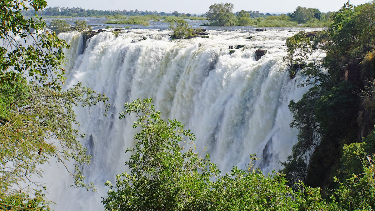
Victoria Falls
Located on the Zambezi River, at the of Zambia and Zimbabwe, Victoria Falls is the largest moving body of water on Earth. You can see the columns of spray for miles away as water thunders down through the rocks. The falls were named by the infamous Dr David Livingstone, for Queen Victoria. Also known as Mosi-oa-Tunya (the Smoke that Thunders), is a spectacular waterfall located on the Zambezi River in southern Africa. It is considered one of the most remarkable natural wonders on the continent and has been recognized as a UNESCO World. Visiting Victoria Falls offers a remarkable opportunity to witness the raw power and natural beauty of one of Africa’s most impressive landmarks. The awe-inspiring sight, combined with the range of activities and cultural experiences, makes it a must-visit destination for nature lovers and adventure seekers alike.
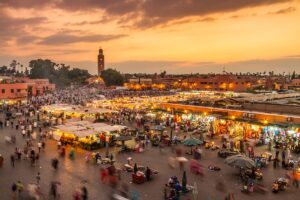
Morocco
Morocco
No trip to Morocco is complete without a visit to Marrakesh Medina. The old city is filled with stall vendors, food stands, traditional musicians, snake charmers and acrobats. Tucked away from the busy streets visitors will find a beautiful garden, the Jardin Marjoelle. There is also a Berber museum inside the gardens where you can find out more about the history and culture of the area. The charm of the city can be seen it the tiny alleyways, a colorful experience that will excite your sights and taste buds. In Morocco’s eastern Sahara region, are the grand sand dunes of the Erg Chebb. Explorers and adventure seekers can dune surf, four wheel drive through the dunes, or take a camel for a ride through the desert.
Cape Town South Africa
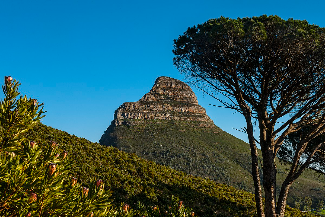
Lion Head
Cape Town is a vibrant and cosmopolitan city located on the southwestern coast of South Africa. It is known for its stunning natural beauty, diverse culture, and rich history. Cape Town’s unique blend of natural beauty, cultural diversity, and historical significance make it a captivating destination. Whether you’re seeking adventure, relaxation, or a cultural experience, Cape Town offers a range of attractions and activities to suit every traveler’s interests.
Maasai Mara, Kenya
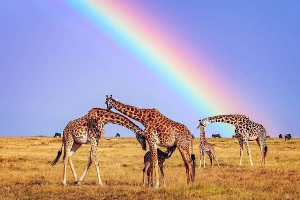
Maasai Mara, Kenya
The Massai Mara is one of the top 10 tourist attractions in Africa, not just to see but experience the big 5 but because of the wildebeest migration. Continuing through the Maasai Mara National Reserve will lead you to the Serengeti National Park and Game Reserves in Tanzania.
There are many specialist tours of this impressive nature reserve and with a variety of game viewing experiences from regular overland vehicles to hot air balloons.
Best time to visit: The cold season from July to October is the best time to visit. This is peak season and can be costly.
Explore the Wild Beauty of Africa with Our Unforgettable Safaris
Embark on a journey like no other with our African safaris. Africa, a continent blessed with diverse landscapes and an abundance of wildlife, offers an unparalleled experience for nature and adventure enthusiasts.
Experience the Majestic Wildlife
Our safaris provide you with the opportunity to witness the majestic wildlife in their natural habitat. From the thundering herds of the Great Migration in the Serengeti to the solitary leopard prowling in the shadows of the Kruger National Park, every moment is a spectacle in itself.
Discover Diverse Landscapes
Africa’s landscapes are as diverse as its wildlife. Traverse the golden savannahs, explore the dense rainforests, navigate the vast deserts, and marvel at the stunning coastlines. Each region offers a unique backdrop for your safari adventure.
Cultural Immersion
African safaris are not just about wildlife. They are also a gateway to understanding the rich cultures and traditions of the local tribes. Engage with the Maasai, Himba, or San Bushmen to gain a deeper insight into their unique way of life.
Sustainable and Responsible Tourism
We believe in responsible tourism. Our safaris are designed to have minimal impact on the environment and contribute positively to local communities. We strive to ensure that Africa’s beauty and biodiversity are preserved for future generations.
Join Us
Whether you’re a seasoned adventurer or a first-time explorer, our African safaris offer an unforgettable journey into the heart of the wild. Join us and experience the magic of Africa.



